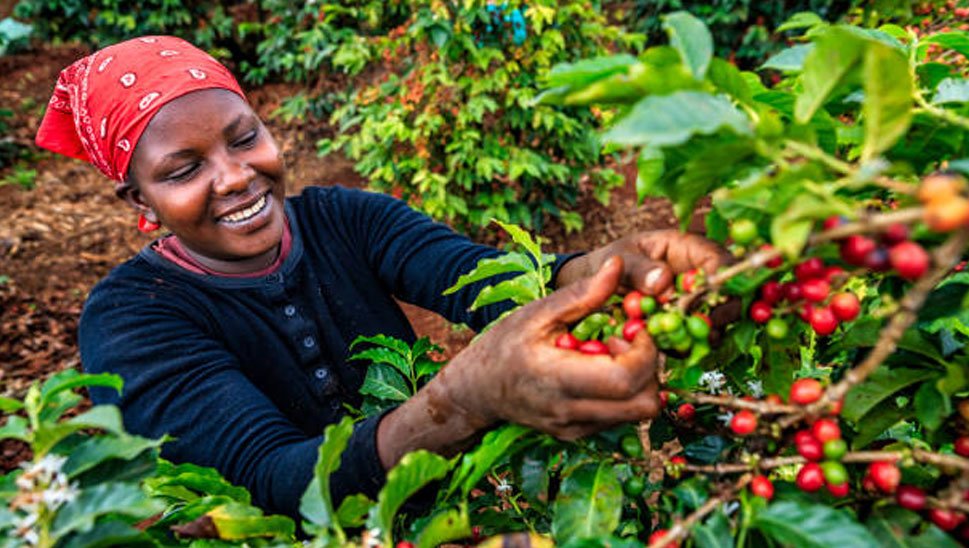Wild About Coffee!

We all enjoy a chat over a cup of coffee.
Let’s take a quick look at the background of this much loved beverage.
The tropical climatic conditions required to grow coffee are retained within what is called “the coffee belt”. This area stretches right around the world along the equator, from the Topic of Cancer in the north to the Tropic of Capricorn in the south, a longitudinal distance of about 5,186km.
There are two types of coffee plants, Robusta and Arabica.
The Robusta is a manageable sized bush which can be grown at fairly low altitudes of between 200m-800 metres. Farming plantations can use mechanical equipment to assist with the harvesting. It is commonly used for instant coffee and has a bitter and astringent flavour with a high caffeine content (2.2 to 2.7%).
The Arabica tree requires a higher altitude, above 800m, often growing wild in hillside forest environments. Harvesting by hand with the use of ladders is often necessary, thus increasing production costings. The reward is a smooth, mild, well balanced flavour with a the lower caffeine content (1.2 to1.5%).
After picking the "cherries" they are split open and the bean is extracted. After washing and laying out in the sun to dry, the beans are shipped all over the world to be roasted and blended. The taste of the bean can easily deteriorate due to change in temperature and humidity throughout all of the processing, so careful monitoring is essential.
The coffee used in the cafe is Ethiopian Mocha Djimma.
This is an Arabica Organic Coffee manually harvested from trees naturally growing in the wild. Known as the “the mother of coffee”, Djimma has an intense wine flavour with the overtones of dark chocolate.
Could you ask for anything more!
Choosing the best drink for you.
If you not conversant with the different ways of serving coffee, ordering to suit your taste can become confusing! We are often asked to explain the difference between Espresso, Americano, Latte, Mocha and Cappuccino. It's a diverse subject, but we will do our best to give a concise answer!

This is the magical beginning of all the coffee drinks. This method of coffee making, originating in Italy in the late 18th and early 19th century, has now has been much improved by the introduction of a highly sophisticated, efficient espresso machine. The roasted coffee beans are ground down to a fairly fine powder and firmly compressed. Hot water is forced through the finely ground coffee at very high pressure (130psi) This process is used to express the coffee flavors in the espresso, giving a caffeinated drink that is richer and bolder than regular coffee. The pressurised hot water forced through the ground coffee causes the trapped CO2 out which combines with the oils and floats on top - known as “the crema”. An espresso coffee is very strong with a very real kick, normally served neat in very small cups. For a larger drink an Espresso is topped up with hot water and renamed an "Americano" - a black coffee, often served with a small jug of hot or cold milk on the side to be added to taste.

This is the magical beginning of all the coffee drinks. This method of coffee making, originating in Italy in the late 18th and early 19th century, has now has been much improved by the introduction of a highly sophisticated, efficient espresso machine. The roasted coffee beans are ground down to a fairly fine powder and firmly compressed. Hot water is forced through the finely ground coffee at very high pressure (130psi) This process is used to express the coffee flavors in the espresso, giving a caffeinated drink that is richer and bolder than regular coffee. The pressurised hot water forced through the ground coffee causes the trapped CO2 out which combines with the oils and floats on top - known as “the crema”. An espresso coffee is very strong with a very real kick, normally served neat in very small cups. For a larger drink an Espresso is topped up with hot water and renamed an "Americano" - a black coffee, often served with a small jug of hot or cold milk on the side to be added to taste.

The complete opposite to the espresso, as the name implies, it produces a very milky drink. An espresso is made in a normal sized cup or glass and then hot frothly milk is poured quickly on top. A long spoon is often used to ensure complete mixing and a froth design placed on top can give an appealing finish. A “Flat White” is the same, (without the froth design), but with a double portion of coffee. Coffee and chocolate blend well together, indulge in a couple of spoonfuls of pure chocolate added to your latte and you have a "Mocha".

The complete opposite to the espresso, as the name implies, it produces a very milky drink. An espresso is made in a normal sized cup or glass and then hot frothly milk is poured quickly on top. A long spoon is often used to ensure complete mixing and a froth design placed on top can give an appealing finish. A “Flat White” is the same, (without the froth design), but with a double portion of coffee. Coffee and chocolate blend well together, indulge in a couple of spoonfuls of pure chocolate added to your latte and you have a "Mocha".

After making the espresso it is swirled around in the cup to leave a lining of coffee around the sides. Hot frothed milk is slowly and gently added to lay on top of the coffee. This results in the espresso staying at the bottom with the milk and froth above. The coffee around the inside walls of the cup being lifted to the surface. Drinking the espresso through the milky froth to give a creamy finish is appreciated by most palettes. A minimal sprinkling of chocolate powder is often placed on the surface.

After making the espresso it is swirled around in the cup to leave a lining of coffee around the sides. Hot frothed milk is slowly and gently added to lay on top of the coffee. This results in the espresso staying at the bottom with the milk and froth above. The coffee around the inside walls of the cup being lifted to the surface. Drinking the espresso through the milky froth to give a creamy finish is appreciated by most palettes. A minimal sprinkling of chocolate powder is often placed on the surface.

